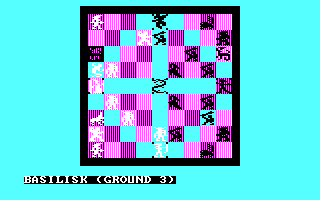45th game played so far
Genre: Fighting/Strategy
Platform: Various
Year of Release: 1983
Developer: Free Fall Associates
Take chess. Add an extra row to the board, with a few more pieces. Change the looks of them, to divide them visually and give them seperate abilities. Have pieces battle each other instead of automatically capturing others. And put in some more strategic options, like having the strength of your characters depend on the colour of the tile they’re on (which, of course, changes). You then have Archon, a strategic fighting game of sorts that might seem like chess-plus, but is actually harder to pin down than that.
Our Thoughts
Here we are for one of the older games for a while, which (to be honest) took us some time to get used to. Fighting and strategy don’t sound like two genres easy to combine, but when you get Battle Chess like I thought it worked when I first played it, you get something more interesting. (Yeah, I started off playing Battle Chess badly). Yes, this is a far more complex game than Battle Chess. When we read up on the desciption I envisaged a game version of the holographic chess from Star Wars. Instead what you have is a game that is chess because of the use of black and white squares, various pieces and the fact that it is turn based. But that’s where the similarity with chess ends, really. When you try to capture a piece, you instead get dropped into a battle interface where you fight the other piece. Your ‘king’ (wizard or sorceress) can use spells to revive pieces, send elementals after your opponents, exchange pieces or other useful things. Then there’s the pieces themselves, which (with their crude looks) represent fantasy creatures like unicorns, basilisks, manticores and golems. Considering the limited number of pixels used they were able to successfully make the pieces look like what they are meant to (the banshee looked perfect). The only one that doesn’t is the unicorn which looked more like a frog. It also raised the question of why a unicorn would be a projectile piece… but that’s a discussion for people in the fanfiction world. This is a 1983 game… obviously the graphics are quite different from the games we’ve played recently, while this game also goes for some more differentiation that other games (like Pac Man) don’t really need as much. When you switch to that mindset, the graphics work and get distinct and interesting enough.
When we look past those ‘known’ issues, the main issue I had were with the controls – it may sound small, but having to press the fire button and then aim to fire is different to what we’re used to, where pressing the fire button just fires. Something I really liked was that there were subtle differences between how different pieces could be played. During the battles you had the knights/goblins which were the melee combatants, the shapeshifter mimiced whatever piece it opposed, certain pieces who attacked with projectiles were slower than others… and so on.
This doesn’t even mention to the strategic elements of the game. Since the injuries you sustain in battle remain with each piece until the end of the game you need to remember which ones are injured and how much. Also the squares themselves change colour at random interval, the meaning of this being that certain colours granted certain bias. For example if a battle took place on a light square the white pieces would find themselves with an advantage in battle. This means that you need to think before you move as an ill-placed battle can see the loss of a very strong piece. Although your spellcaster can heal your pieces occasionally, which can help them for a little while. You get a real crash course in this from playing single player against the AI which, I have to admit, made it seem very intelligent for a 1983 computer game. The AI has one setting – very hard – and leaves you no chances. I got flattened in my first game and did a bit better on the second, but still lost by quite a margin.
Final Thoughts
The comparisons with chess are misplaced, really. The board layout may suggest such, and there might be some superficial similarities, but when you really look at it, they’re little more than superficially similar, and trying to compare them is futile.
Archon is a lovely strategy game where your fighting reflexes count for quite a bit too, and the two elements combine really well to create a fun game that’s worth playing if you prefer some more action while still having to focus on the strategy, setting up who fights who and how to best get there.
